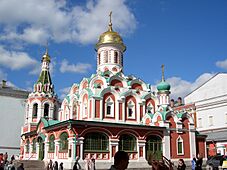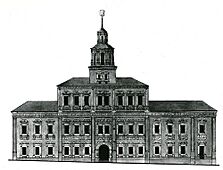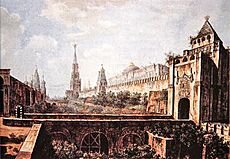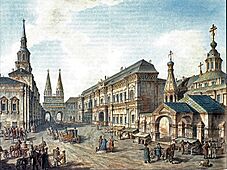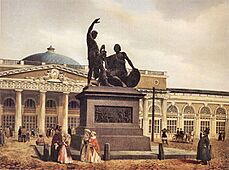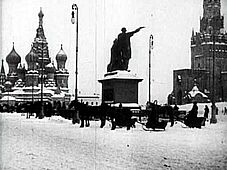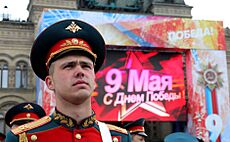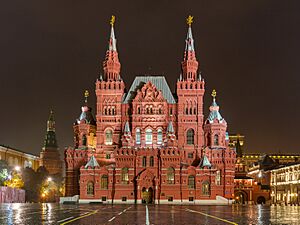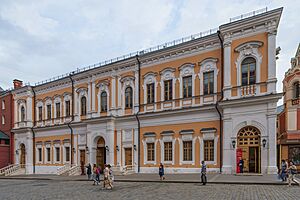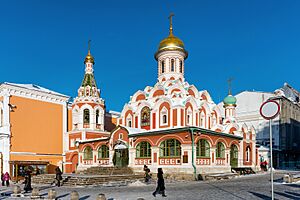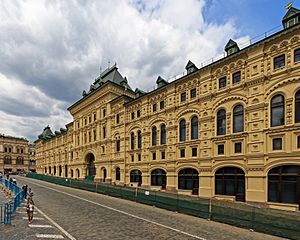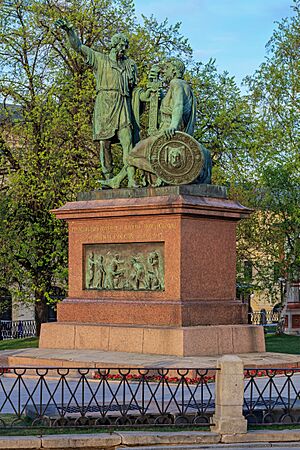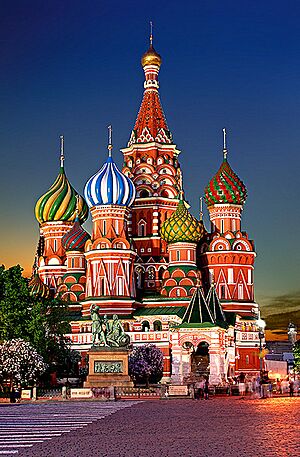Red Square facts for kids
| UNESCO World Heritage Site | |
|---|---|
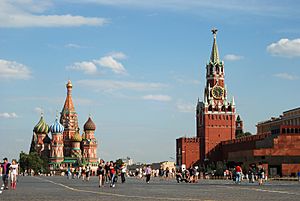 |
|
| Location | Moscow, Russia |
| Criteria | Cultural: i, ii, iv, r ,87 |
| Inscription | 1990 (14th Session) |
Red Square (Russian: Красная площадь, tr. Krasnaya ploshchad') is one of the most famous and largest squares in Moscow, Russia. It sits in the heart of Moscow, right next to the eastern walls of the Kremlin. This square is a super important landmark, home to amazing buildings like Saint Basil's Cathedral, Lenin's Mausoleum, and the GUM department store.
Since 1990, Red Square has been a UNESCO World Heritage Site. Over the years, it has hosted many big events. These include parades, speeches, and even some protests. The square covers about 73,000 square meters (800,000 square feet). It is just east of the Kremlin and north of the Moskva River. A long time ago, a moat separated the square from the Kremlin, but it was filled in during 1812.
Contents
Where is Red Square?
Red Square has a shape that is almost like a rectangle. It is about 70 meters wide and 330 meters long. The square stretches from the northwest to the southeast. It runs along part of the Kremlin wall on its southwest side.
On the northeast side, you'll find the GUM department store. The old area of Kitay-gorod is also there. To the northwest, there's the State Historical Museum and the Resurrection Gate. At the southeast end, you can see Saint Basil's Cathedral.
Tverskaya Street starts behind the State Historical Museum. To the southeast, a slope leads down to the Moskva River. You can cross a bridge there to reach the Zamoskvorechye District. Two streets, Nikolskaya Street and Ilyinka, branch off to the northeast. These streets have been around since the 14th century. Today, most of Red Square is a walking area.
How Red Square Got Its Name
Many main squares in Russian cities are called Krasnaya ploshchad. This means 'Beautiful Square'. Long ago, the Russian word красная (krasnaya) meant 'beautiful'. Now, it means 'red'. The word for 'beautiful' today is красивая (krasivaya).
In Moscow, the name Red Square first described a small area. This was between St. Basil's Cathedral, the Spasskaya Tower of the Kremlin, and the Lobnoye Mesto platform. Later, Tsar Alexei Mikhailovich officially gave the name to the whole square. Before that, it was called Pozhar, meaning "burnt-out place." This was because old buildings there had burned down.
A Look at Red Square's Past
The history of Red Square is shown in many famous paintings. The square was first meant to be Moscow's main market. It was also a place for public events and announcements. Sometimes, a coronation for Russia's Tsars happened here. Over time, buildings were added, and all Russian governments have used the square for official events.
Early Days (Before the 18th Century)
The eastern side of the Kremlin was the most open to attack. It didn't have rivers or natural barriers like other sides. So, the Kremlin wall was built very high here. Italian architects told Ivan the Great to clear the area outside the walls. This created an open space for defense. Buildings within 234 meters of the wall were taken down in 1493 and 1495.
From 1508 to 1516, an architect named Aloisio the New built a moat. This moat was in front of the eastern wall. It connected the Moskva and the now-underground Neglinnaya River. Water from the Neglinnaya River filled it. This moat was 541 meters long and 36 meters wide. It was also 9.5–13 meters deep. In 1533, it was lined with limestone and brick walls.
Three gates were on this side of the wall. In the 17th century, they were called Konstantino-Eleninsky, Spassky, and Nikolsky. The Spassky Gate was the main entrance to the Kremlin for royal visits. Wooden and later stone bridges crossed the moat from this gate. Books were sold on these bridges.
The square was first called 'Great Market' or just 'Market'. Then it was called 'Troitskaya' after a church that burned down in 1571. After that fire, it was known as 'Pozhar' (burnt). It wasn't until 1661–62 that it was first called Krasnaya (Red or Beautiful) Square.
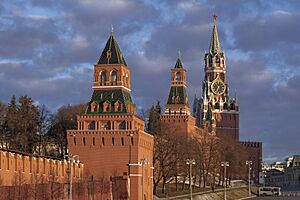
Red Square became Moscow's main trading spot. Even though rules tried to limit trade, permanent market buildings soon appeared. After a fire in 1547, Ivan the Terrible organized the wooden shops into market rows. Streets like Ilyinka and Varvarka were divided into Upper, Middle, and Bottom lines for trade.
Later, Saint Basil's Cathedral was built on the moat under Ivan IV. This building gave the square its unique look. In 1595, the wooden market rows were replaced with stone ones. A brick platform called Lobnoye Mesto was also built. This was for announcing the tsar's orders.
Red Square was a special, sacred place. Many parades and celebrations happened there. On Palm Sunday, a famous "procession on a donkey" took place. The patriarch, riding a donkey, would go from Saint Basil's Cathedral to the Kremlin with the tsar and the people.
During the war in 1612, Prince Dmitry Pozharsky entered the Kremlin through the square. To remember this, he built the Kazan Cathedral. It honored the "Kazan Icon of the Mother of God," which had been with his army.
Around the same time (1624–1625), the Spasskaya tower got its famous tent-shaped roof. This was thanks to Christopher Galloway from Scotland. He designed the new tower's clock and suggested the roof. Later, a golden double-headed eagle was placed on top. After this, the square was sometimes called Krasivaya (beautiful).
By the late 17th century (1679–1680), all wooden buildings were removed from the square. All Kremlin towers, except Nikolskaya, received tent roofs. A special tower, the Tsarskaya Tower, was built on the wall. From here, the tsar could watch ceremonies in the square. Tent roofs were also added to the Voskresensky (Iberian) gates.
In 1697 and 1699, buildings were rebuilt on both sides of Voskresensky Bridge. These included the Mint and the Zemsky prikaz (a department for city and police matters). The Zemsky prikaz building later housed the first Russian University in 1755. The drained Alevizov moat was used as a garden for medicinal plants.
-
Execution of streltsy by Tsar Peter I (to the right on a horse) in Red Square, 1698 (painted 1881)
Changes in the 18th Century
In 1702, Russia's first public theater was built near the Nikolsky gate. It was used until 1737, when a fire destroyed it. In the 1730s, a new mint building, called the Gubernskoye pravlenie, was built.
Catherine the Great wanted to improve the square. In 1786, the upper floor of the market lines was made of stone. This line was on the opposite side of the square, near a moat. Architect Matvey Kazakov then built a new Lobnoye Mesto from cut stone. It was placed slightly west of its old spot.
The 19th and Early 20th Centuries
In 1804, the square was paved with stone at the request of merchants. Nikolskaya Tower was rebuilt in 1806 in a Gothic style. It also received a tent roof. More improvements came after Napoleon's invasion and the fire in 1812. The moat was filled in 1813, and trees were planted there.
The market line along the moat was damaged by the fire. It was torn down. On the eastern side, Joseph Bové built new market lines in the Empire style. In 1818, the Monument to Minin and Pozharsky was put up. It showed the rise of national pride during the war.
In 1874, the old Zemsky prikaz building was demolished. The Imperial Historical Museum was built in its place. It was designed in a pseudo-Russian style. After Bové's market lines were removed, new large buildings went up between 1888 and 1893. These were also in the pseudo-Russian style. They included the upper lines (GUM department store) and middle lines. The upper lines were for retail shopping. They were Moscow's first department store. The middle lines were for wholesale trade. In 1892, electric lanterns lit up the square. In 1909, a tram ran on the square for the first time.
-
Minin-Pozharsky monument from 1818 commemorating the expulsion of the Polish forces from Moscow, 19th century
Soviet and Modern Times
During the Soviet era, Red Square remained very important. It became a main spot for the new government. It was known for military parades starting in 1919. Lenin's Mausoleum became part of the square in 1924. It served as a viewing stand for important people during national celebrations.
In the 1930s, Kazan Cathedral and Iverskaya Chapel with the Resurrection Gates were taken down. This made space for large military vehicles during parades. Both were rebuilt after the Soviet Union ended. There were even plans to demolish Saint Basil's Cathedral and the State Historical Museum. This would have made Red Square even bigger.
A story says that Lazar Kaganovich, a helper of Joseph Stalin, showed Stalin a model of Red Square. He removed the cathedral to show how it blocked parades. But Stalin supposedly said, "Lazar! Put it back!" However, there is no official proof of this story.
In 1963, African students held a protest on Red Square. This was in response to the death of a medical student. It was the first political protest there since the late 1920s. On May 28, 1987, a pilot from West Germany, Mathias Rust, landed a small plane near St. Basil's. This caused a big scandal for the Soviet Air Defense Forces.
In 1990, the Kremlin and Red Square became some of the first sites in the USSR to be added to UNESCO's World Heritage List.
Red Square has also hosted many big concerts. Bands like Linkin Park, The Prodigy, Shakira, and Red Hot Chili Peppers have played there. For New Year's celebrations in 2006, 2007, and 2008, a skating rink was set up. Paul McCartney's concert was special for many. The Beatles were banned in the Soviet Union, so they couldn't perform there before.
Parades and Celebrations
Two very important military parades happened on Red Square. The 1941 October Revolution Parade saw troops leave the square directly for the front lines. Moscow was under attack by Germans then. The Victory Parade in 1945 celebrated the defeat of Nazi armies. Their banners were thrown at the foot of Lenin's Mausoleum.
The Soviet Union held many parades on Red Square. These were for May Day (until 1969), Victory Day, and October Revolution Day. These parades showed off propaganda, flags, workers, marching troops, tanks, and missiles.
Since 1995, the annual Moscow Victory Day Parade has been held on the square. It marks the anniversary of Nazi Germany's defeat in World War II. In January 2008, Russia announced it would again parade military vehicles through Red Square. On May 9, 2010, for the 65th anniversary of Germany's surrender, soldiers from France, the United Kingdom, and the United States marched in the parade for the first time.
-
2008 Military parade marking the sixty-third anniversary of Victory in the Great Patriotic War
-
Red Army soldiers cheer Joseph Stalin in Red Square in a scene from the 1942 film Moscow Strikes Back
Famous Buildings of Red Square
Let's take a look at the buildings around Red Square, starting from the northwest.
State Historical Museum
The dark red building of the State Historical Museum stands at the northwest end of Red Square. It was built between 1875 and 1883. This makes it one of the newer parts of Red Square's architecture. Before it, Moscow's first pharmacy stood here in the early 18th century. Later, in 1755, it became the first campus for Moscow State University.
The museum building was specially built for the new historical museum, founded in 1872. It opened in May 1883. Its architect, Vladimir Osipovich Sherwood, used a "Russian style." This style looks like traditional Russian buildings. The museum has arched windows and decorations like old churches. It also has decorative towers, similar to some Kremlin towers. The roof shape looks like the Great Kremlin Palace.
Today, the Historical Museum is Russia's largest and most famous history museum. It has about 4.5 million items about Russian history from all time periods. It also holds special exhibitions. Besides the main building, the museum includes Saint Basil's Cathedral and the Novodevichy Convent. The convent is also a UNESCO World Heritage site.
Resurrection Gate
The Resurrection Gate is one of two entrances to Red Square from the northwest. This structure was first built in 1680. It was part of the Kitai-Gorod defenses. It has two arched doorways and two rectangular towers. The tops of these towers look like Kremlin towers.
The gate was once part of a group of buildings at the north end of Red Square. These included a government building and a pharmacy. During the Russian Empire, the gate was a special entrance to Moscow. Tsars would pass through it for their coronation celebrations.
In 1931, the gate was taken down by the new government. They wanted to make space for military vehicles during parades. Today's gate is a copy of the original, built in 1996. Between the two doorways on the north side, the chapel of the icon of the Mother of God of Iviron was also rebuilt. A new copy of the icon was made for this chapel.
Former Government Building and Mint
This building stands between the Resurrection Gate and the Kazan Cathedral. It was built between 1733 and 1740. For a long time, it was the main office for Moscow city and regional government. The building was damaged during the war against Napoleon in 1812.
In the 1810s, architect Joseph Bové helped rebuild it. A tower was added to the roof, used as a fire station lookout. This tower was later removed in the early 20th century.
Inside the courtyard, you can still see the old state mint building. It was built in 1697 by Peter the Great. It made silver coins for almost 25 years. After that, it was used as a Debtors' prison for merchants who couldn't pay their debts. Today, both this building and the former government office are part of the Historical Museum.
Kazan Cathedral
The Kazan Cathedral is next to the former government building, on the corner of Red Square and Nikolskaya Street. The cathedral you see today is a copy from 1993. An earlier church stood here since the 1620s, first made of wood, then stone from 1636.
The Kazan Cathedral is named after the icon of Our Lady of Kazan. This icon is very important to the Russian Orthodox Church. Legend says this icon helped the Russian army, led by Kuzma Minin and Dmitri Pozharsky, defeat the Military of the Polish–Lithuanian Commonwealth in 1612. After the victory, Prince Pozharsky built the cathedral to honor the icon. This was a common way to remember important Russian victories.
In the 17th and 18th centuries, Kazan Cathedral was a very important church in Moscow. It hosted special processions led by the patriarch and the tsar. These often celebrated the victory over the Polish-Lithuanian Commonwealth.
In 1936, Joseph Stalin approved the demolition of the cathedral, like many other churches in Moscow. But in the early 1990s, people called for it to be rebuilt. The reconstruction finished in 1993. This made Kazan Cathedral one of the first churches destroyed in the Soviet era to be rebuilt.
GUM Department Store
The GUM department store is on the eastern side of Red Square. It takes up the whole area between Nikolskaya and Ilyinka streets. Because it's right on Red Square and is very large (about 35,000 square meters), GUM is Russia's most famous shopping center.
Built in 1893, it replaced an older building from 1815. That building housed the Upper Trading Ranks, which brought together much of Kitai-Gorod's trade. When the old building started to fall apart, plans for a new one began. The new building was designed by architect Alexander Pomeranzewas and engineer Vladimir Schuchow. Construction lasted from 1890 to 1893.
When GUM opened in 1893, it amazed people with its huge range of goods. It also had a new glass roof design by Schuchow, using about 60,000 glass panes. The building's style is "Russian style," like the Historical Museum. It has a roof gable like 16th-century palaces, two decorative towers like the Kremlin, and a main front that looks like old Russian buildings.
During the Soviet era, GUM had an interesting history. In 1921, it got its current name, GUM. This stood for 'State Department Store'. In the early 1930s, it closed for 20 years and was used as offices and homes. From 1953 until the end of the Soviet Union, it was a model department store.
In the 1990s, GUM became a private business and was renovated. Today, it is a fancy shopping center with high-end boutiques. Since 2013, GUM has hosted a yearly Christmas fair in front of the store. It is the biggest one in Russia.
Middle Trade Rows
This building is at the easternmost point of the square, on the corner of Ilyinka Street. It stands where the Middle Trading Rows were in the 17th century. These rows, along with the Upper Trading Rows (now GUM), were part of the big market area of Kitay-gorod.
The first building for trade here was built in the late 18th century. It was designed by Italian builder Giacomo Quarenghi. But it burned down in the war of 1812. The Middle Trading Rows building you see today was rebuilt by Joseph Bové.
The current Middle Trade Rows building was finished in 1894, around the same time as GUM. It was meant to go with GUM. GUM was for retail, and this building was for wholesale trade. That's why they look very similar. The architect was Roman Klein, who designed many other Moscow buildings.
After the Bolsheviks took power, the building was no longer used for trade. It became offices for various government groups. Until recently, it belonged to the Russian Armed Forces. In 2007, parts of the building were taken down. There were plans to rebuild it as a fancy hotel. This caused some debate. Now, work is underway to create a museum inside the building. This new museum will be part of the UNESCO-protected Moscow Kremlin Museums. It will show some items from the Kremlin Armoury outside the Kremlin walls.
Lobnoye Mesto
The Lobnoye Mesto is a round, white stone platform. It's in the southeastern part of the square, in front of Saint Basil's Cathedral. It is one of the oldest buildings on the square that we know about. Lobnoye Mesto was first mentioned in 1549. That's when the 19-year-old tsar Ivan The Terrible gave a speech there. So, it was likely built as a platform for announcing tsar's orders to the people.
The name Lobnoye Mesto might mean 'forehead' or 'skull'. But some think it's named after its location near a steep river bank. The platform was first made of wood. The stone building with an iron gate dates from the late 1590s. Over time, Lobnoye Mesto was used for state announcements and important events. The patriarchs of the Russian Orthodox Church gave speeches there during services.
The Lobnoye Mesto also became known as a place for executions. For example, Stenka Rasin was executed nearby in 1671. But the executions didn't happen directly on the platform itself. After Saint Petersburg became Russia's capital, Lobnoye Mesto lost its role as the tsar's platform. It has been a monument ever since. In 1786, it was rebuilt and moved a few meters east.
Monument to Minin and Pozharsky
This monument honors two Russian heroes, Kuzma Minin and Prince Dmitri Poszharsky. It stands right in front of Saint Basil's Cathedral. It was built between 1812 and 1818. Like the Kazan Cathedral, it remembers the liberation of Moscow in 1612. Minin and Poszharsky led a popular army that helped defeat the Polish–Lithuanian occupation.
The bronze monument weighs 20 tons. It was paid for by donations. Sculptor Ivan Martos designed it. After almost 15 years of planning, it was unveiled in February 1818. Russia had just stopped the French invasion by Napoleon five years earlier. Moscow was also just rebuilt. So, the monument was seen as a symbol of Russia's strength and its heroes.
Originally, the monument was in front of the GUM department store. It was moved to its current spot in 1930. This made more space for military parades and large demonstrations.
Saint Basil's Cathedral
Saint Basil's Cathedral is at the southern end of the square. It is definitely the most famous building on Red Square. It is also one of Russia's cultural symbols. This church was once Moscow's main place of worship. Today, it mostly works as a museum, part of the State Historical Museum. Since the early 1990s, services are sometimes held there.
In the mid-16th century, a wooden church stood here. In 1555, Tsar Ivan the Terrible ordered a huge church to be built. This was to celebrate Russia's victory over the Khanate of Kazan three years earlier. Building churches to remember military victories was a tradition then. The wooden church was taken down, and the current cathedral was built by 1561. This makes it one of the oldest buildings on the square.
The cathedral's common name comes from Basil the Blessed. Tsar Ivan respected him greatly. Basil was buried near the cathedral after his death in 1522. Ivan Barma and Postnik Yakovlev were among the church's popular architects.
From its completion until Russia's capital moved to Saint Petersburg, it was Moscow's most important church. It hosted special services for all major Orthodox holidays. The cathedral faced threats of destruction many times. Legend says Napoleon ordered it blown up when he left Moscow in 1812. But a sudden rainstorm put out the fuses.
In 1918, after the October Revolution, the Bolsheviks closed the cathedral. Its head priest was executed. There were plans to demolish the cathedral. But architect Pyotr Baranovsky personally fought against these plans, saving the building.
The cathedral's unique, uneven style makes it stand out from other Russian Orthodox churches. It has nine church towers with bright, onion-shaped domes. These domes are different sizes and colors. This means the building looks interesting from every side. It was first built of white stone. During a renovation in the mid-17th century, red bricks were added. This gives it its striking mix of colors today. Inside, the cathedral has a maze of corridors and galleries.
Eastern Kremlin Wall
The eastern part of the Kremlin wall and Red Square appeared in the 15th century. This was during the rule of Ivan III. The wall and square were separated by a wide defensive moat. Water from the Neglinnaya River filled it. The moat had a smaller fortress wall and three bridges connecting the Kremlin to the city.
The northernmost of the three Kremlin towers is the 70-meter-high Nikolskaya Tower. It is named after Saint Nicholas, whose icon was once on the tower. This tower is one of four Kremlin towers with an entrance gate. It was built in 1491 by Pietro Antonio Solari, an Italian architect. In 1806, Nikolskaya Tower was greatly changed to a Gothic style. This was very unusual for the Kremlin. Napoleon's troops destroyed it a few years later. It was rebuilt in 1816 with help from Joseph Bové. Its Gothic style still makes Nikolskaya Tower the most unique of the twenty Kremlin towers.
The Spasskaya Tower is the main tower of the Kremlin's eastern wall. It is probably the most famous Kremlin tower. It also has an entrance gate. This gate, along with Saint Basil's Cathedral, closes off the south side of Red Square. The tower is named after an image of the Savior that once hung above the gate. It is over 71 meters tall. Like Nikolskaya Tower, it was built by Pietro Antonio Solari in 1491. But it was about half its current height then. The tower got its current shape after being rebuilt in 1624–1625. A bell tower with a large clock, designed by Christopher Galloway, was added. This clock is the tower's most famous part today. Its four dials, one on each side, date back to 1852. Each dial is 6.12 meters across. The clockwork takes up three floors of the tower. A dozen bells ring every 15 minutes.
Both the Nikolskaya and Spasskaya Towers have a three-meter-wide red star on top. These stars are made of ruby and agate glass. They were symbols of Communism. They were placed on five Kremlin towers in 1937. Before that, the towers had the Imperial Russian double-headed eagle.
The small tower near Lenin's Mausoleum, between the Nikolskaya and Spasskaya Towers, is the Senatskaya Tower. It was built in 1491 by Pietro Antonio Solari. It was purely for defense, guarding the Kremlin on the Red Square side. For a long time, it had no name. In 1787, after architect Matvei Kazakov built the Kremlin Senate, it got its current name. You can see the Senate's dome from Red Square. The tower has three levels of arched rooms inside. In 1860, a stone tent roof with a gilt weather vane was added. The tower has a passage for important people to travel between the Kremlin and Red Square. It is 34.3 meters tall.
Lenin Mausoleum
An important building from the Soviet era is the Lenin Mausoleum. It is on the western side of the square, by the Kremlin wall. It stands where the protective moat used to be. Inside, the carefully preserved body of Vladimir Lenin rests in a glass coffin. The mausoleum is still open to visitors on certain days.
The building you see today is made of granite and labradorite. Before it, there were two temporary mausoleums made of oak. The first was built in January 1924, a few days after Lenin died. The current building was built between 1929 and 1930. It looks like a multi-level pyramid. This design was meant to show it as a grand burial place, like ancient tombs. The famous architect Alexey Shchusev designed it.
From when it was finished until the end of the Soviet Union, the mausoleum was a central attraction. During military parades, leaders stood on the roof of the mausoleum. In 1953, the body of Joseph Stalin was also placed in the mausoleum. But eight years later, he was removed during a process called de-Stalinization. He was then buried at the Kremlin wall.
Today, the mausoleum still draws many tourists. However, keeping Lenin's body on display is a debated topic. Many famous people, including Mikhail Gorbachev, have said Lenin should be buried.
Kremlin Wall Cemetery
Right behind Lenin's Mausoleum, along the Kremlin walls, is a large cemetery of honor. It was created in November 1917. About 250 soldiers who died during the October Revolution in Moscow were buried there. They were placed in two shared graves near the Senate tower.
The tradition of burying revolutionaries on Red Square continued. In 1919, Lenin's friend Yakov Sverdlov was buried at the Kremlin wall. With Lenin's Mausoleum finished in 1930, this burial place became its main feature. Since then, the mausoleum and the surrounding cemetery are called the Revolutionary Necropolis.
From the 1920s to the 1980s, hundreds of people were buried in Red Square. These were considered the most deserving people of the Soviet Union. They included revolutionaries, heroes of the Soviet Union, leaders, and military commanders. Being buried here was a very high honor.
Twelve leaders, including Sverdlov, Mikhail Kalinin, Kliment Voroshilov, Leonid Brezhnev, and Stalin (until 1961), were buried in individual graves. Many revolutionaries rest in 15 shared graves. Most burials here are niches in the Kremlin wall. Over 100 urns with the remains of important people are sealed there. These include Lenin's partner Nadezhda Krupskaya, the first cosmonaut Yuri Gagarin, writer Maxim Gorky, and nuclear scientist Igor Kurchatov. Foreign politicians like Clara Zetkin are also there.
The cemetery on the Kremlin wall became a memorial in 1974. After the funeral of leader Konstantin Chernenko in 1985, no more burials have happened there. You can visit the tombs of the cemetery when you visit the mausoleum.
Sports Events
The Russian Bandy Federation and the Moscow Patriarchate hold the Patriarch's Cup every year. This event includes bandy tournaments, even bandy played in boots.
See also
 In Spanish: Plaza Roja para niños
In Spanish: Plaza Roja para niños
- Alexander Garden
- Kremlin towers
- Kremlin Wall
- Kremlin Wall Necropolis
- Lubyanka Square
- Saint Basil's Cathedral






